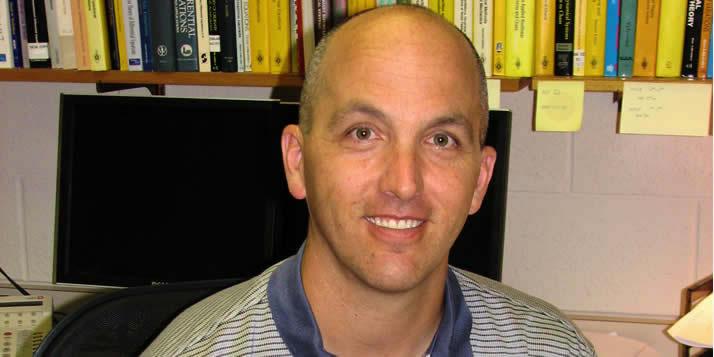Superatom man

Kapitula recently earned a $142,969 grant from the National Science Foundation (NSF) for his research on superatoms.
Todd Kapitula doesn’t mind the cold. “Coming to a winter place doesn’t bother me at all,” says Kapitula, a professor of mathematics who taught for 11 years at the University of New Mexico before making the switch to Calvin this past year. “I have three small kids, and I like doing whatever it is you do with small kids in the winter.”
Colder than deep space
He also likes playing with cold atoms, very cold atoms, atoms that are exposed to temperatures much more frigid than the coldest part of deep space. “The coldest you can get in deep space is four degrees Kelvin,” Kapitula said. “It is much colder than that. We’re talking nanokelvins (billionths of a degree Kelvin)—so, very, very cold.”
Atoms exposed to these extremes of low temperature, said Kapitula, become immobilized. “When they just sit there, they start talking to each other,” he explained. “When they’re talking to each other, they want to all be the same.” The cold atoms, as many as 30-to-50 thousand of them, begin behaving as a unit; they exhibit the same patterns. Together, they form what is known as a “superatom.”
“You can stir these things with lasers or you can punch a hole in them,” Kapitula said. “This is fundamental science. We’ve created this really cool thing, and then we mess with it.”
Creation before application
Kapitula recently earned a $142,969 grant from the National Science Foundation (NSF) for his research on superatoms, a project that he titled “Waves in Hamiltonian Systems with Applications to Bose-Einstein Condensates.” The grant, spread out over three years, allows Kapitula to work with two Calvin student researchers per summer.
Kapitula emphasized that he doesn’t do any actual experimentation. He leaves the messing to others and concentrates on the math. “I want to understand the patterns that you see,” he said. “Let’s say we understand why certain patterns are generated and some aren’t,” he said. “This is the Holy Grail of an applied mathematician. If you solve this equation, you may have a reasonable explanation of what’s gone on in the experiment. There may be some very profound implications later on.”
There may also be applications later on, Kapitula added, for an entity like the superatom: “The laser came in the 1960s. The applications came later,” he explained. “You create the thing first.”
Human and non-human collaborators
To solve the equations based on the experiments (the first of which was conducted in the ’90s) Kapitula may have to rely on Dahl, Calvin’s second generation of supercomputer. “If I’m going to simulate anything real,” he said, “I’m going to need supercomputing ability.”
Kapitula has an ongoing collaboration on his research with P. G. Kevrekidis, a mathematical physicist at the University of Massachusetts, Amherst and Zhigang Chen, a physicist at San Francisco State University. The three earned an Outstanding Paper Prize from the Society for Industrial and Applied Mathematics (SIAM) for an article based on their research: “Three is a Crowd: Solitary Waves in Photorefractive Media with Three Potential Wells.”
Kapitula remembered getting the e-mail announcing the SIAM honor: “I was going to delete, and I noticed it was addressed to me and my two co-authors,” he said. “I read it and thought it was a joke.” Both of his collaborators had the same reaction. “Finally, we accepted it was real,” he said.
Math in the real world
As one of three applied mathematicians on the faculty, Kapitula provides a much-needed augmentation of Calvin’s mathematics and statistics department, said department chair Mike Stob. “The distinction is based on how closely the mathematics they worked on is motivated by and comes out of real-world problems,” he said of applied mathematics. “Todd’s specialty is the application of mathematics to physics.”
Kapitula was also a find for Calvin because he brought with him an established research program, said Stob: “It’s really hard for a brand-new PhD to come up with a research program with the heavy teaching load at Calvin. So we’ve always found that people who come here with a research program underway find it easier to maintain it.”
The studier of superatoms brings another big bonus with him, added Stob: His wife, Laura, a statistician, who will commence her Calvin teaching career in 2009. “She will be our only PhD statistician, even though we teach 500 students a year statistics,” said Stob. “We got two people in areas we really needed.”
Equations are not simply puzzles to Kapitula; they embody the “language of the Creator,” he said. “The same equation can be used to model light going down an optical fiber or deep water waves,” he said. “An equation has a beauty to it, a structure to it that should not be there—unless there was a Creator. When I do math, I see the beauty of creation, the structure of creation.”
Baptized in the Russian Orthodox Church, Kapitula spent 30 years as an agnostic-atheist. He became a Christian in 1999. “God,” he summarized, “is patient.”






